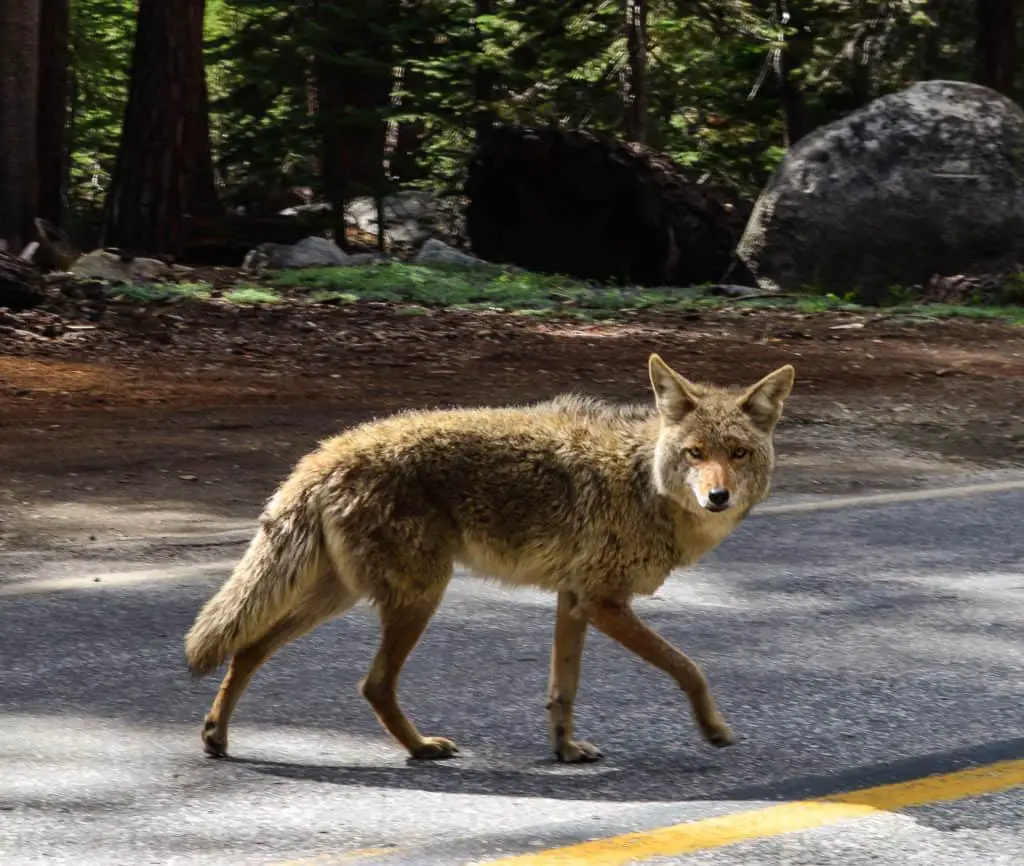Table of Contents
Q: Do coyotes come out during the day?
A: While coyotes are known for being active at night, this does not mean that they stay completely hidden during the day. Let me tell you my personal experience with spotting coyotes during the day, in addition to some academic research on the topic.
I live in an extremely populated suburban area in Michigan. Across the street from my house is a wooded area that is maybe 2 or 3 acres. In those woods is a group of coyotes that we have heard routinely through the summer, mostly at night, when the windows are open. We have also heard them during the day when their howling has been activated from sirens on fire trucks leaving a nearby fire station. Yes, sirens send them into a howling frenzy.
View the video below to get an idea of what they sound like. Needless to say that it is difficult to sleep when this haunting howling is echoing into the bedroom window at 3AM.
While these coyotes have vocally made themselves known, we haven’t ever seen them in the darkness of night. However, we have seen them twice during the day (afternoon time) in our yard over approximately two years of hearing them on and off in the woods near my house. My neighbor stated that he also saw one sitting in the street in the light of the morning. So yes, coyotes do come out during the day but they are less likely to be seen in comparison to many other animals.
A Kansas State article titled Understanding the Coyote states that coyotes typically forage from around dusk to a few hours after sunset. Secondially, it is also not unusual for them to look for food prior to sunrise. The article goes on to state that ” However, they may forage at any time of the night or day” . In other words, if they happen to foraging for food during the day, there is a chance that they will come out in the open to be seen by humans.
Are humans safe around coyotes?
Firstly, the chances of coming face-to-face with a coyote is rare. While you can occasionally see one during the day, they are a nocturnal animal. They are not use to seeing humans and will typically be scared off by a human encounter.
However, the Humane Society states that a coyote that is not afraid of humans has likely become accustomed to humans. This likely means they have been given a food source such as dog food left outside or have found an unsealed trash source that has allowed them to become comfortable in the human environment. Of course, the greater the frequency of encounters of humans and coyotes means that there is also a greater chance of a coyote attack. But, how common are coyote attacks on humans?
Smithsonian.com reports that over a 30 year period, ending in 2006, there were at least 160 attacks on humans. The majority of these attacks occurred in Los Angeles County where the human population has grown with that of the coyote population. Children have historically been the most at risk for an attack.
Fatal attacks are even more infrequent with only two confirmed attacks that resulted in death. One attack was in Glendale, California in 1981 on a three-year-old and another was in 2009 on a nineteen-year-old woman in Nova Scotia.
In summary, there are pretty good odds you won’t get attacked much less die. However, you should be cautious and be aware that coyotes can pose a threat, especially toward pets.
Are pets safe around coyotes?
Small dogs and cats are most at risk for an attack. However, the number of coyote attacks on pets is hard to pin down since animals go missing or can be injured out of the sight of humans. In other words, it is often a guessing game on what injured or caused a pet not to return home.
Medium and large breeds of dogs can also be attacked by coyotes. The Urban Coyote Research Project completed research on coyote attacks on dogs in the Chicago area. Of the 29 dogs attacked, 20 were small, 3 were medium, and 6 were large breeds. The larger breeds were typically attacked by multiple coyotes [source].
It should not be assumed that pets are safe when coyotes are in the area. This is particularly true when they are left unaccompanied. Precautions should be taken when coyotes are believed to be or known to be in the area.
Protecting against coyotes
Here are some tips to help protect against the dangers of coyotes:
- Keep your dog, especially smaller ones, on a short leash when coyotes are active in your community. This means not only on walks but in the backyard as well.
- Keep your cat indoors at all times. All domesticated cats are small enough to be an easy targets for coyotes to attack.
- Do not leave food sources outside that will attract coyotes. This means things like dog food, open trash cans, compost piles, and sources of water.
- If possible, fence your yard. This is an excellent deterrent for not only coyotes but other pests such as skunks. However, a fence is not 100 percent foolproof. The fence should be at least 6 feet tall, otherwise, there is a decent chance that a coyote can scale over it. Coyotes also have the ability to dig so the fence should be extended down to further deter entry into the yard.
- Learn to haze coyotes to reinforce in them that humans are to be feared. This essentially means doing things that will scare them off such as creating loud noises or spraying them with a hose when you see them. This one is often difficult to pull off since often everyone in the community needs to participate in hazing in order for it to be effective.
- Coyotes tend not to like light, especially if it is flashing. You should consider purchasing motion sensor lights or a product like Predator Guard found on Amazon that flashes red lights when an animal approaches the device. The animal thinks the lights are a set of eyes and runs off to a safer hunting area.
- Lastly, use shears or another type of cutting tool to remove bushes or vegetation where coyotes can hide in the yard.

